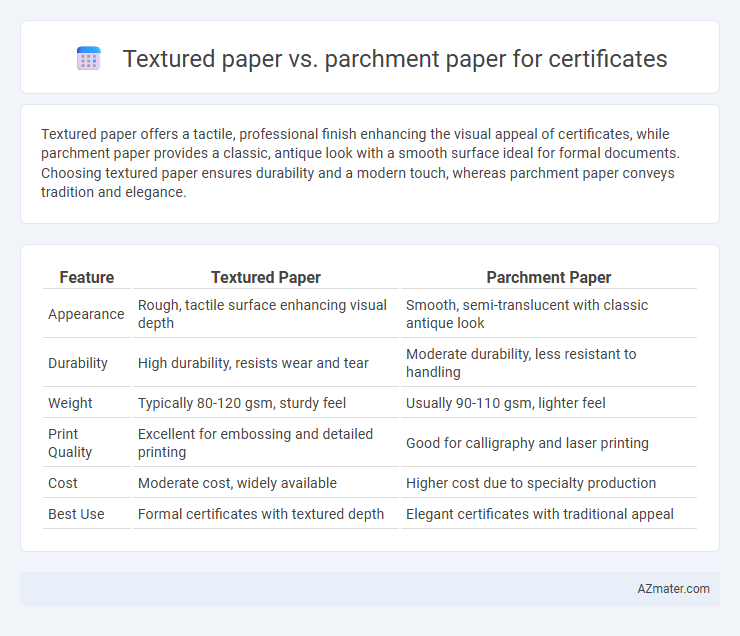Textured paper offers a tactile, professional finish enhancing the visual appeal of certificates, while parchment paper provides a classic, antique look with a smooth surface ideal for formal documents. Choosing textured paper ensures durability and a modern touch, whereas parchment paper conveys tradition and elegance.
Table of Comparison
| Feature | Textured Paper | Parchment Paper |
|---|---|---|
| Appearance | Rough, tactile surface enhancing visual depth | Smooth, semi-translucent with classic antique look |
| Durability | High durability, resists wear and tear | Moderate durability, less resistant to handling |
| Weight | Typically 80-120 gsm, sturdy feel | Usually 90-110 gsm, lighter feel |
| Print Quality | Excellent for embossing and detailed printing | Good for calligraphy and laser printing |
| Cost | Moderate cost, widely available | Higher cost due to specialty production |
| Best Use | Formal certificates with textured depth | Elegant certificates with traditional appeal |
Understanding Textured Paper and Parchment Paper
Textured paper offers a tactile surface with raised patterns, enhancing the visual appeal and perceived quality of certificates by providing a premium, professional finish. Parchment paper mimics the classical look of traditional parchment with a smooth, slightly translucent surface, ideal for formal documents that require an elegant, timeless appearance. Both paper types ensure durability and high print quality, but textured paper emphasizes a distinctive tactile experience while parchment paper prioritizes a refined, aged aesthetic.
Key Differences in Appearance
Textured paper features a tactile surface with visible patterns or grain, creating a traditional and elegant feel ideal for certificates requiring a sophisticated look. Parchment paper exhibits a smooth or slightly mottled finish with a semi-translucent appearance, mimicking historical documents for an antique or formal aesthetic. The key difference in appearance lies in textured paper's pronounced surface patterns versus parchment paper's smooth, classic, and refined visual appeal.
Durability and Longevity Comparison
Textured paper offers enhanced durability due to its thicker fibers and embossed surface, making certificates resistant to wear and tear over time. Parchment paper, while aesthetically classic with its smooth, slightly translucent finish, may be more susceptible to creasing and fading under frequent handling or exposure to light. For long-lasting certificate preservation, textured paper provides superior longevity and resilience compared to parchment paper.
Suitability for Certificate Printing
Textured paper offers a refined and tactile finish that enhances the visual appeal and professionalism of certificates, making it ideal for official awards and recognitions. Parchment paper, with its traditional, slightly rough surface and antique appearance, provides a classic and prestigious look favored for formal and historical-style certificates. Both types support high-quality ink absorption, but textured paper excels in crisp detail presentation, while parchment paper adds a vintage charm, influencing suitability based on the certificate's intended style and formality.
Writing and Printing Compatibility
Textured paper offers enhanced ink absorption and a tactile feel, making it ideal for handwritten certificates where calligraphy and penmanship are prioritized. Parchment paper, with its smooth surface and slight translucency, provides excellent compatibility with inkjet and laser printers, ensuring sharp, professional print quality for digitally produced certificates. Choosing the right paper depends on whether the certificate emphasizes hand-crafted writing or high-resolution printed text.
Cost Considerations
Textured paper generally costs more than parchment paper due to its higher-quality fibers and unique surface finish, making it a premium choice for certificates requiring a luxurious feel. Parchment paper offers a more budget-friendly option while still providing a classic, elegant appearance suitable for formal documents. Balancing cost with desired aesthetics, textured paper is preferred for high-end awards, whereas parchment paper suits bulk printing needs without compromising on traditional appeal.
Professionalism and Prestige
Textured paper enhances the professionalism of certificates by adding a tactile quality that signifies attention to detail and quality, often favored in formal awards and recognitions. Parchment paper, with its classic and elegant appearance, elevates the prestige of certificates, evoking tradition and authenticity valued in academic and official documents. Choosing between textured and parchment paper depends on whether the goal is to emphasize refined craftsmanship or timeless credibility in certificate presentation.
Environmental Impact
Textured paper for certificates often involves natural fibers and fewer chemical treatments, making it more biodegradable and eco-friendly compared to parchment paper. Parchment paper, typically coated with silicone or other chemicals to ensure non-stick properties, has a higher environmental impact due to its reduced recyclability and longer decomposition time. Choosing textured paper minimizes waste and supports sustainable forestry, aligning with environmentally responsible certification practices.
Customization and Finishing Options
Textured paper offers a tactile surface that enhances customization through embossing, foil stamping, and spot UV coating, providing certificates with a sophisticated, artisanal finish. Parchment paper, characterized by its smooth, semi-translucent quality, excels in traditional printing and calligraphy, allowing for rich ink adherence and classic, elegant presentation. Both options support high-resolution printing, but textured paper tends to deliver more versatility in finishing techniques, making it ideal for highly personalized and premium certificate designs.
Choosing the Right Paper for Your Certificate
Textured paper offers a tactile, elegant feel that enhances the visual appeal and prestige of certificates, making it ideal for formal recognitions and awards. Parchment paper provides a classic, antique look with a smooth finish, lending a timeless and official appearance suitable for academic or legal certificates. Choosing the right paper depends on the desired aesthetic and durability, with textured paper emphasizing sophistication and parchment paper emphasizing tradition.

Infographic: Textured paper vs Parchment paper for Certificate
 azmater.com
azmater.com